The original publishing of this article can be found here. Written by Ale Vergara of Bee Partners and Bogdan Cristei of Union Labs Ventures. They are early-stage, deep tech investors and members of the Bay Area Deep Tech community.

TL; DR
It is no surprise that the World Economic Forum marked Climate Change as a key risk for the next decade. In order to tackle a problem of this magnitude, we need international collaboration and both public and private entities to work alongside. Software alone won’t solve the climate crisis, and as deep tech investors, we see exponential growth opportunities in software-enabled hardware and engineering-based technologies. These are innovations ready for commercialization that have the potential for above-market returns and positive impact.
We believe in a future in which every company is a climate company, which means there are a lot of technologies (and their respective paths to commercialization) to keep track of. To support our own research process, we’ve created the framework below and will continue to define and write about Climate with these four buckets in mind:
- Renewing Energy Systems
- Fueling the Carbon Economy
- Restoring Earth Systems
- Accelerating Response and Mitigation
INTRODUCTION
Earlier this year, The World Economic Forum outlined the key risks for 2023 and it’s no surprise that climate change holds the top position [1] for the next decade. Extreme weather, climate action failure, and large-scale environmental damage are some of the vertical issues that stem from the broader risk factor.
Addressing this is no longer an option, and if there’s one thing we all learned from Covid, it’s that in order to tackle a problem of this magnitude and complexity, we need international collaboration and both public and private entities to work alongside.
This decade represents a window of opportunity. As described by the Planetary Boundaries, a framework that defines a safe operating space for humanity, in which we can “continue to develop and thrive for generations to come”. Crossing these boundaries puts us in dangerous territory, and if we don’t act, potentially leads to a point of no return. [2]
We have thought long and hard about our role as individuals and as representatives of our venture capital firms as it relates to the climate crisis. When we think about our fiduciary responsibility with our LPs, Climate Tech is front and center: if we don’t curb the current trend line, there is no future for any human ecosystem, company, or individual to thrive. It is our duty and responsibility to take action now.
Software alone won’t solve the climate crisis [3], and as deep tech investors, we see exponential growth opportunities in software-enabled hardware and engineering-based technologies. These innovations are ready for commercialization and have the potential for above-market returns and positive impact.
Broadly, deep climate technologies include solutions aimed at decarbonization. We believe in a future in which every company is a climate company, which means there are a lot of technologies (and their respective paths to commercialization) to keep track of. We’ve created the framework below and will continue to define and write about Climate with these four buckets in mind:
- Renewing Energy Systems
- Fueling the Carbon Economy
- Restoring Earth Systems
- Accelerating Response and Mitigation
This piece is not meant to serve as an investment thesis, but rather, it’s meant to highlight different pockets in the Climate Economy that we believe are crucial components for decarbonization.
For each of the buckets mentioned above, we have listed a number of questions and statements to spark curiosity and perhaps bring a new iteration in research and thesis-building. This is certainly how we think about leveraging the initial part of our work.
RENEWING ENERGY SYSTEMS

WHERE TO START?
A collection of thoughts
- Energy independence isn’t just a climate issue, it’s a national security issue.
- Many overestimate the amount of visibility grid operators have today.
- Adding real-time visibility on generation, transmission, and distribution is critical. Understanding the value of implementing resiliency strategies is even more so.
- The electric grid is more ancient than people realize and the way we move electricity around isn’t designed to meet future demand. It’s a fragmented patchwork.
- Our electric grid is a set of disparate systems that need to be tightly interconnected. To meet future demand, we need more high-voltage transmission lines that better connect our cities and communities.
- As electrification gains momentum, the reliability of the electricity supply becomes more important, especially during abnormal conditions such as extreme weather and cyber-attacks (both increasingly more common). For many reasons, our existing infrastructure needs updating.
- We need technologies that increase the reliability of a more dynamic and distributed electric grid. Examples include digital technologies such as network monitoring devices and smart meters that can improve visibility.
- DERs have the potential to provide valuable services to the grid when properly incentivized with the right technologies, policies, and regulations.
- As centralized power generation loses ground to distributed energy resources (DERs), more control of the system at the edge will be needed. We will see more marketplaces, smart pricing mechanisms, and free market movement (as is the case in countries outside the US)
- We need to be able to store energy for weeks and months at an order of magnitude lower cost than what is available today. We need batteries that are much more dense at a significantly lower price.
- Mining methods used to extract lithium from rocks, brines and clays have changed little in the past century [4]. They rely on mechanical and chemical processes that are inefficient and damaging to the environment. If we are to close the Lithium (and other critical minerals) supply gap, mining and processing need to be rethought.
- We need to create industrial process heat through electricity rather than chemistry.
- The only way to scale solar efficiently is by incorporating vertical software solutions and automation—systems manufacturing, placement, cleaning & maintenance
- Wind and Solar are more affordable than ever, but they’re not always available. They will only get us to 80% decarbonized electricity. To reach the remaining 20%, we need to find other ways to generate clean and reliable energy—scaling nuclear fusion and geothermal energy resources are top of mind.
- Green Hydrogen is known as the “Swiss Army Knife” for a reason. If we can bring down its production costs, multiple applications abound. In particular, long-haul transportation (long-distance trucking, shipping, and aviation) stands as a key beneficiary.
BREAKING IT DOWN
Three key categories
- Energy technologies are crucial to the transition to a low-carbon economy, including renewable energy sources such as solar, wind, and geothermal, as well as energy storage solutions like batteries and hydrogen technologies.
- Infrastructure and planning are necessary to support the deployment of renewable energy technologies. This includes grid and transmission planning to ensure that renewable energy sources can be integrated into the system, and intermittent resource management such as wind and solar, to ensure a consistent supply of energy.
- Enabling technologies focus on the technologies and processes that enable renewable energy deployments and the transition to a low-carbon economy. This includes the use of deep data analytics, machine learning, and artificial intelligence to optimize energy systems, as well as supply chain and process changes to reduce emissions and increase efficiencies. Security is also a critical consideration as the energy system becomes more decentralized and vulnerable to cyberattacks.

FUELING THE CARBON ECONOMY

WHERE TO START?
A collection of thoughts
- In the “Impact Era”, enterprises will rise and fall based on their ability to adapt to the new world of scrutiny and accountability. Every enterprise is going to need decarbonization plans + the infrastructure and data to turn these plans into action.
- There is a misalignment in the industry between stated corporate goals and budgets needed for particular itemized actions due to a lack of reliable data. Companies need to undergo digital transformation processes to track meaningful decarbonization projects.
- There’s a profound sense of data paralysis built into company cultures. There’s the aspiration to be a data-driven organization and have data-informed decision-making, but when it comes to massive sea change (ie. transforming an organization around ESG, decarbonization, and climate), this aspiration can do more damage than good. Sometimes, it’s more effective to begin in the right direction and adjust accordingly.
- Many organizations are stuck in three generations of consultant reports; every other year, they have a different consultant come in and give them a spreadsheet. But the spreadsheet isn’t really actionable, as a ‘de novo’ artifact that lives outside of any decision-making system.
- Demand for decarbonization is loud and clear: Capital Markets are rewarding ESG commitments. The 5 biggest banks have dedicated $330B/yr to ESG investing[5], while a group of 301 asset managers with USD $60 trillion in assets has committed to achieving net zero alignments;[6] The Fortune 5000s have committed $12 trillion to achieve environmental, social & corporate governance (ESG) goals and 90% of Fortune 500 have ESG commitments with worldwide corporate budgets at $1.4 trillion.[7]
- In 2022 the Voluntary Carbon Market exceeded $1B in transaction volume and is expected to be at $50B per annum by 2030. Supply can’t keep up: today only ~500 forest carbon projects exist worldwide and we need closer to 5 million projects to make a difference. [8]
- Despite the above, VCMs have only gained momentum in the last five years—coinciding with a bull market and companies with cash to spend. As interest rates rise and the economy slows down, those who’ve claimed carbon credit spend as non-discretionary will be put to the test.
- Carbon markets are inefficient and obscure. Project enrollment is complex and inefficient: it represents around 40–60% of the credit value for landowners, making it prohibitive for small landowners to participate in the market. Credits are heterogenous—they have different characteristics depending on the underlying project and hence, differ in price.
- We need common features to describe the quality of carbon credits. Greater transparency through open rubrics and calculation methods will reduce transaction costs and create a better match between sellers and buyers in the market.
- Criteria to consider when thinking about the ‘quality’ of carbon credits include (1) additionality, (2) permanence, (3) leakage. Projects need a “baseline” scenario to compare to and an established way of monitoring progress over time.
- Carbon Removal has traditionally meant planting or maintaining trees, but removing CO2 from the atmosphere and storing it in the ground, the ocean or in products significantly increases permanence.
- We need to develop methodologies to verify that new Carbon Removal technologies not only work in the real world but also that their impact is a net positive for the environment.
BREAKING IT DOWN
Three key categories
1. Environmental Impact Reduction refers to the strategies, policies, and technologies aimed at minimizing or eliminating the negative impact of human activities on the environment. This can include efforts to reduce greenhouse gas emissions, air and water pollution, waste generation, and habitat destruction.
2. Decarbonization and Climate Mitigation refers to the efforts to reduce carbon emissions and limit the impact of climate change. Decarbonization involves the shift away from fossil fuels and towards renewable energy sources, such as wind, solar, and hydropower. Climate mitigation efforts include carbon capture and storage, afforestation, and land-use changes.
3. Carbon-to-Value refers to the wide variety of commercial products made with the CO2 emissions captured from power plants, biomass, or direct air capture. When addressing the market, think about: better carbon alternative products, cost competitiveness, and alignment with existing supply chains.
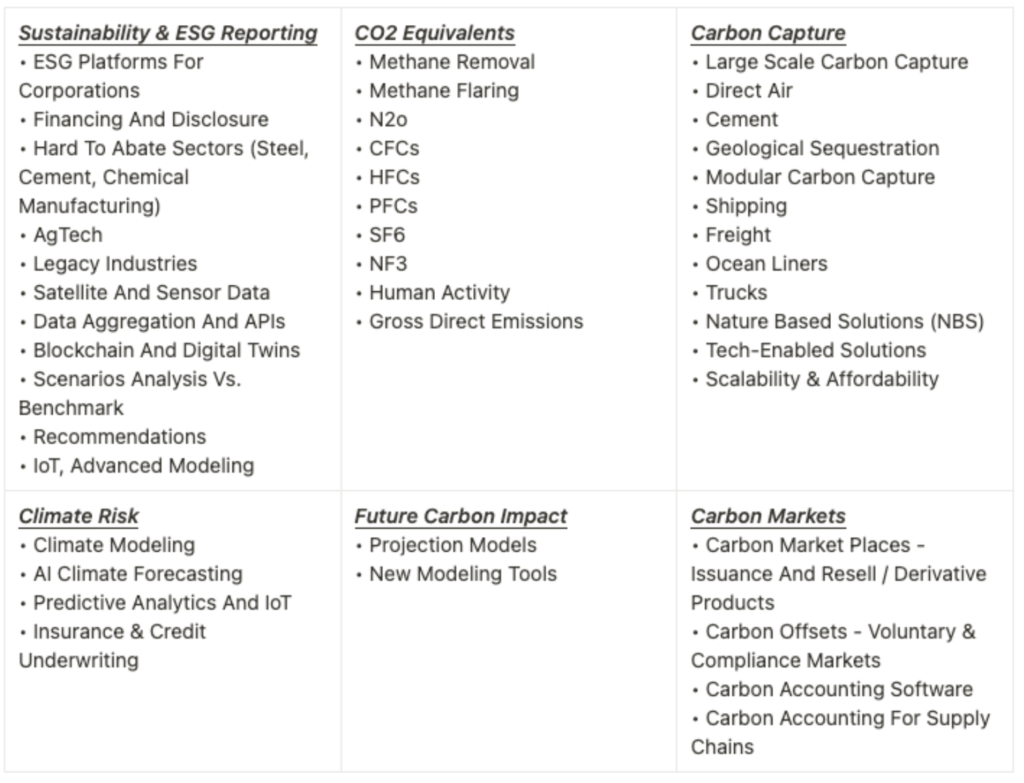
RESTORING EARTH SYSTEMS

WHERE TO START?
A collection of thoughts
- Ecosystem restoration is defined as a process of reversing the degradation of ecosystems, such as landscapes, lakes and oceans to regain their ecological functionality. This can be done by speeding up regenerative capacity by focusing on natural mechanisms that can be amplified by human interventions. [9]
- 20% of the planet’s vegetated surface shows declining trends in productivity with fertility losses linked to erosion, depletion and pollution. By 2050 degradation and climate change could reduce crop yields by 10% globally and by up to 50% in certain regions. [10]
- This year’s World Environment Day will kick off the UN Decade on Ecosystem Restoration, a global mission to revive billions of hectares, from forests to farmlands.
- Controlled burns are an important tool for maintaining the health and safety of a forest. [11]
- The changes in seawater chemistry resulting from increased carbon dioxide emissions, collectively known as ocean acidification, will have detrimental impacts to marine ecosystem services and economic activity including wild capture fisheries, aquaculture, recreation, shoreline protection, and others. [12]
- More than 800 million people don’t have access to clean water and at least 2 billion live in unsanitary conditions [13]. In many countries, non-sewered, low-cost sanitation technologies and delivery are urgently needed.
- Some of the biggest challenges in water desalination include transportation and brine disposal and management. Solar and other low marginal-cost renewables are greatly reducing some of these burdens, but there is much to be done.
- Naturally occurring and modified enzymes can be used to remove industrial chemicals from the environment. By harnessing the power of biology, we can remove petroleum, pesticides, plastics, and more. This process is known as bio-remediation.
- Our soil is the world’s most important carbon capture mechanism, as it stores more carbon than all that is in the atmosphere and plant life combined [14]. With deforestation, all that stored carbon is released as CO2.
- Nature provides solutions to both capture carbon and increase crop yields—a necessary value mix when selling to growers. By identifying microorganisms that have the ability to capture carbon, transform it into minerals, and lock it in the soil for thousands of years, we can create more sustainable food systems.
- The use of synthetic fertilizers for agriculture, releases nitrous oxide when broken down by soil microbes. Organic fertilizers aren’t much better, but with the power of biology, we can find ways to avoid their use altogether. Genetically modified microbes can provide plants with the nitrogen they need while avoiding the production of GHG altogether.
- Our soil is being depleted of nutrients due to mismanaged farming. We need more sustainable farming practices that can be deployed at scale.
BREAKING IT DOWN
Three key categories
- Water management strategies are needed to protect this vital resource, ensure access to safe drinking water, and maintain healthy aquatic ecosystems. This can include efforts to reduce water pollution, increase water conservation, and develop sustainable water supply systems.
- Forestry involves the management, conservation, and restoration of forest ecosystems. Forests provide a wide range of ecosystem services, including clean air and water, carbon storage, and habitat for wildlife. However, deforestation, forest degradation, and forest fires are significant threats to these valuable ecosystems. Sustainable forestry practices, such as selective logging, reforestation, and forest protection, can help maintain healthy forests and promote biodiversity while also providing economic benefits to local communities.
- Agriculture is essential for human survival, it can also have significant environmental impacts, such as soil erosion, water pollution, and greenhouse gas emissions. Sustainable agriculture practices, such as crop rotation, agroforestry, and integrated pest management, can help reduce these negative impacts while also increasing productivity and promoting food security. Additionally, sustainable agriculture can support rural development and poverty reduction by providing income and employment opportunities for farmers and rural communities.

ACCELERATING RESPONSE & MITIGATION

WHERE TO START?
A collection of thoughts
- It’s important to think about how to best capitalize on climate change and make progress in an energy transition economy.
- Supply chains play a key role when we think about Climate Change because they generate around 60% of all carbon emissions globally. [15]
- For many organizations, climate change impacts will be felt in the supply chain. Investing in adaptation could yield immense benefits. Delayed adaptation will increase costs to governments and businesses, with some industries potentially becoming uninsurable. Stranded assets are subject to an unanticipated or premature write-down, devaluation, or conversion into a liability.[16]
- Organizations that favor a wait-and-see approach with respect to climate change regulation may believe that this is the ‘economically responsible’ approach. They do not want to disadvantage themselves versus competitors, by incurring extra costs ahead of regulatory demand. Adopting this strategy recognizes that the supply chain needs to adapt, but limits the amount of investment that the organizations are willing to bear. [15] We need creative ways to finance CAPEX investments, in a way that makes economic sense for everyone involved.
- The world generated 53.6 million metric tons of e-waste in 2019. Only 17.4% of that was recycled. The fraction not recycled represents $47 billion in lost value from materials that could have been recovered, including cobalt, palladium, copper, and others. [17]
- Battery recycling will play a crucial role in closing the loop and creating environmentally sustainable EV supply chains. There is eagerness across the board (government and automakers) to reduce foreign supply chain exposure, favoring domestic battery recycling solutions.
- A successful battery recycling company will rely on solid partnerships with automakers, potentially co-locating and offering full-service solutions including collection, shredding, extraction, recovery, refining, and processing.
- The same can be said about Waste Management more broadly, where a holistic approach to the whole process, and not just recycling, will yield venture-like returns.
- Companies are seeking new ways to address growing disruption from extreme weather caused by climate change.
- Materials value chains account for 20% of GHG emissions[18]. Taking a closer look, 98% of construction materials end up in low-value end-of-life applications, and only 17% of annual virgin plastics are recycled.
BREAKING IT DOWN
Three key categories
- Energy and resource management focuses on managing energy and resources in an efficient and sustainable way. Electrification involves converting traditional systems that rely on fossil fuels to electric systems powered by renewable energy sources. Sustainable fuels involve the development of alternative fuels that are renewable and produce fewer emissions. Waste Management involves reducing waste production and finding ways to recycle or repurpose waste materials.
- Risk and crisis management involves identifying and assessing risks, and developing strategies to mitigate or avoid them. Natural disaster management involves preparing for and responding to natural disasters such as hurricanes, earthquakes, and wildfires.
- Technology and innovation focuses on technological advancements. Mobility involves developing new methods of transportation that are more efficient and sustainable, such as electric vehicles and public transportation systems. Fintech involves using technology to improve financial services, such as digital banking and investing platforms.

REFERENCES
[1] “Global Risks Report 2023”; Jan 11, 2023; weforum.org
[2] “Planetary boundaries—Stockholm Resilience Centre”; Jan, 2023; stockholmresilience.org
[3] “Software won’t solve the climate crisis: Deep tech investment is needed”; Oct 15, 2022; VentureBeat
[4] “How to make lithium extraction cleaner, faster and cheaper—in six steps”; Apr 2023; nature.com
[5] “Invest NYC SDG: A Finance White Paper. Models for Financing the UN Sustainable Development Goals”; March 2021
[6] “Net Zero Asset Managers—Signatories”; netzeroassetmanagers.org
[7] “Here’s what you need to know about the $12 trillion ESG investment world”; Dec 18, 2019; marketwatch.com
[8] “Why the Voluntary Carbon Market is Thriving”; 2023; bcg.com
[9] “Ecosystem Restoration—The Regenerative Restoration of Ecosystems”; Feb 18, 2023; rescue.earth
[10] “UN Decade on Ecosystem Restoration”; Nov 10, 2022; decadeonrestoration.org
[11] “Controlled burns are an important tool for maintaining the health and safety of a forest”; Feb 19, 2023; National Geographic
[12] “Economic Impacts of Ocean Acidification: A Meta-Analysis”; Oct 1, 2022; EPA
[13] “Water, Sanitation, and Hygene” ; gatesfoundation.org
[14] “We Should Discuss Soil as Much as Coal”; gatesnotes.com
[15] “How sustainable supply chains can unlock net zero emissions” ; Jan 6, 2022; accenture.com
[16] “Maverick Research: Supply Chains Need Radical Action as ‘Our House Is Still on Fire’”; Nov 4, 2020; Gartner
[17] “Plastic Recycling Is A Dead-End Street—Year After Year, Plastic Recycling Declines Even as Plastic Waste Increases”; Oct 24, 2022 ; [greenpeace.org] (Plastic Recycling Is A Dead-End Street—Year After Year, Plastic Recycling Declines Even as Plastic Waste Increases )
[18] “Capturing the Green Premium Value from Sustainable Materials”; mckinsey.com
“SEC Targets Greenwashers to Bring Law and Order to ESG”; Apr 21, 2021; Bloomberg
“Climate change is the world’s biggest problem. Deep tech investment is our greatest opportunity”; Feb 18, 2023; partnershipsforum.unaa.org.au
“How venture capital investment in deep tech can tackle climate change”; Oct 21, 2021; weforum.org
APPENDIX
The most common barometer for measuring climate impact is CO2 equivalent
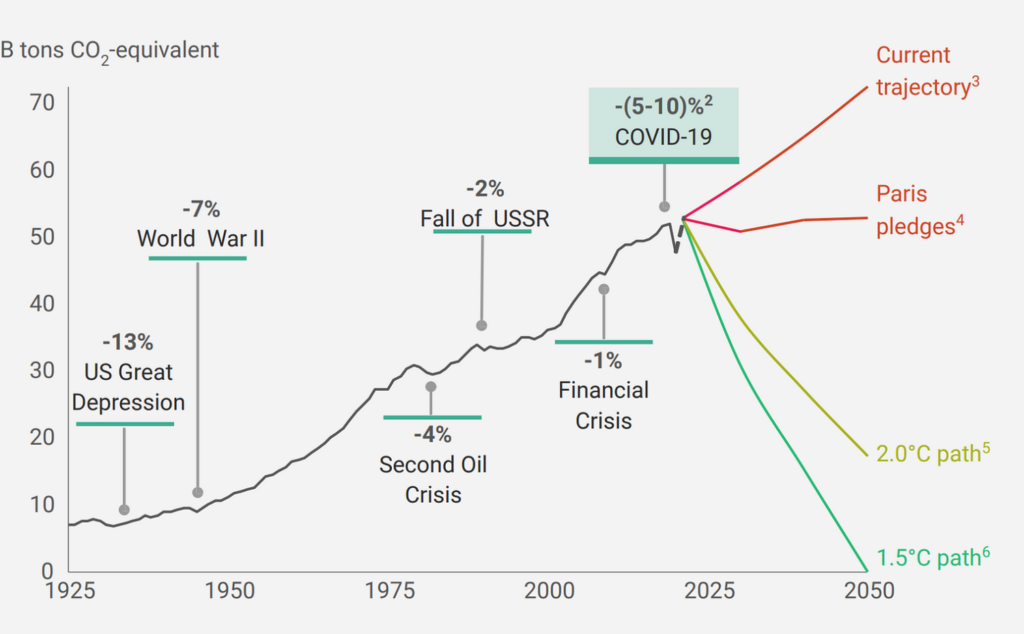
Estimating the environmental impacts of 57,000 food products

Land Management

Securing Critical Metals Market Map
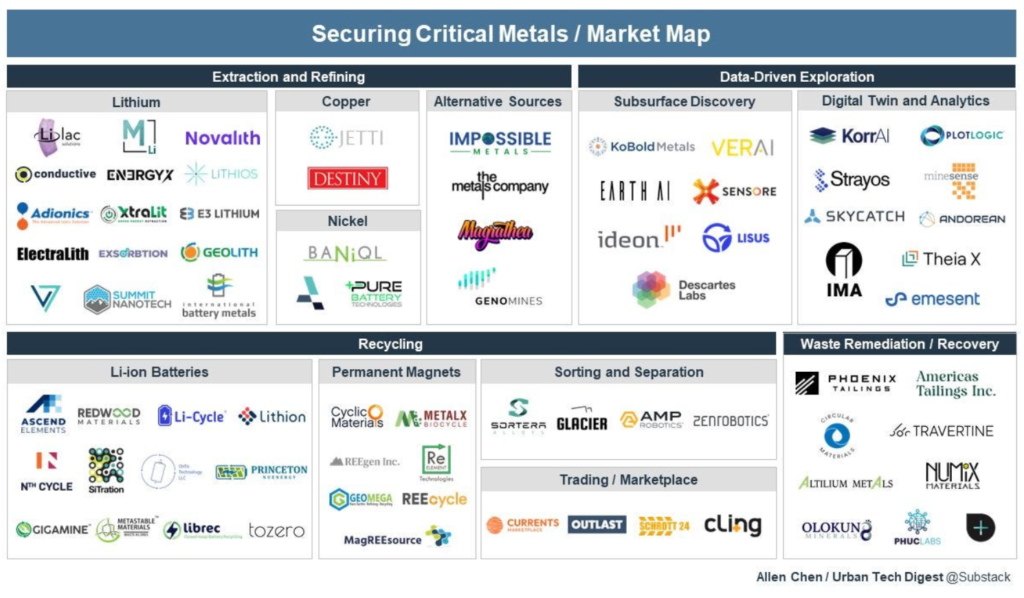
Voluntary Carbon Market

Global greenhouse gas emissions by sector
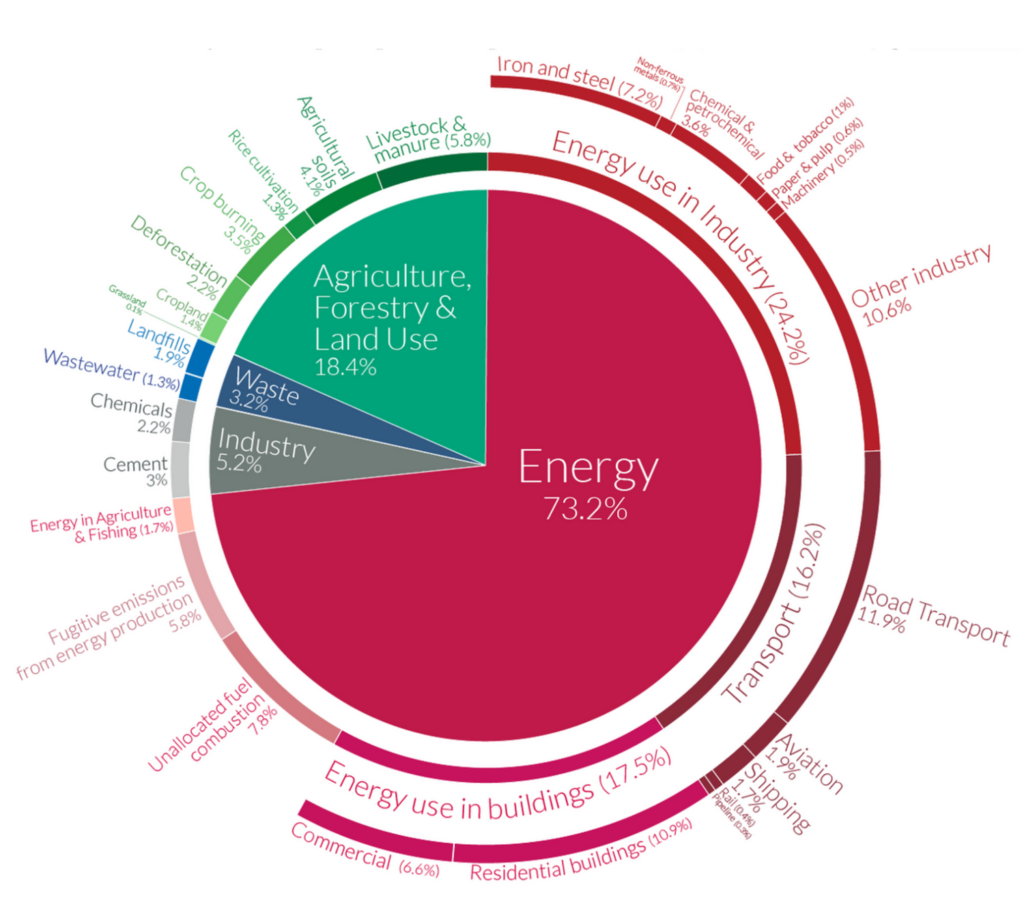
Carbon Storage Methods

$70.1B of Climate Tech Venture Funding
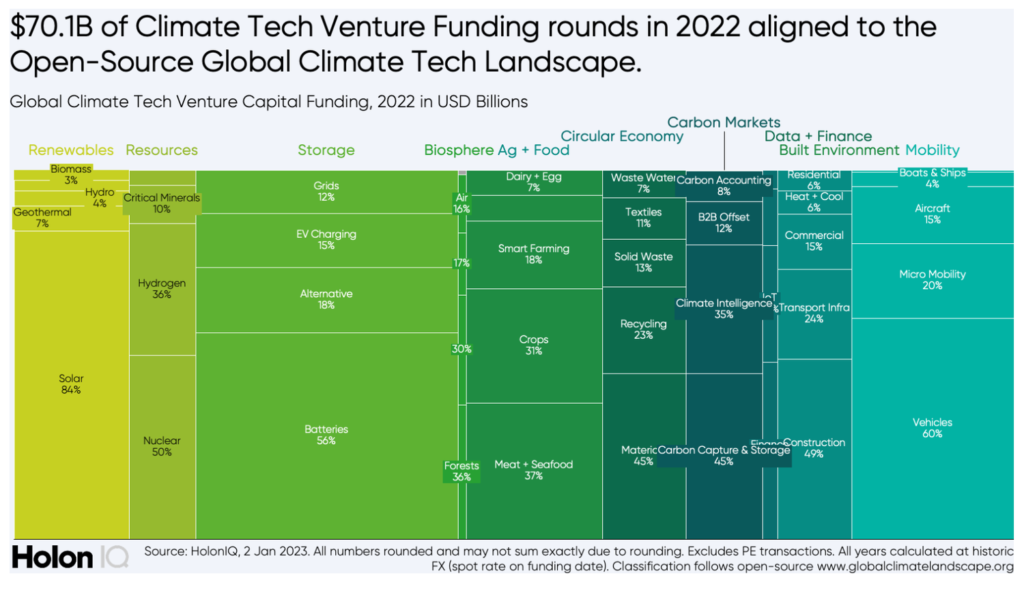
2023 market map of the “new“ voluntary carbon market

FURTHER READING
The world’s largest carbon trader sold worthless carbon offsets for tens of millions of euros
Wren | Offset your carbon footprint
Carbon accounting is hard. These startups want to make it easier
The carbon offset API developer Patch confirms a $4.5 million round led by Andreessen Horowitz
Goldman Sachs raises $1.6 bln private capital for climate fund
A startup says it’s begun releasing particles into the atmosphere, in an effort to tweak the climate
These scientists bonded over toilet tech. Now they’re working on carbon-free cement

No Comments.